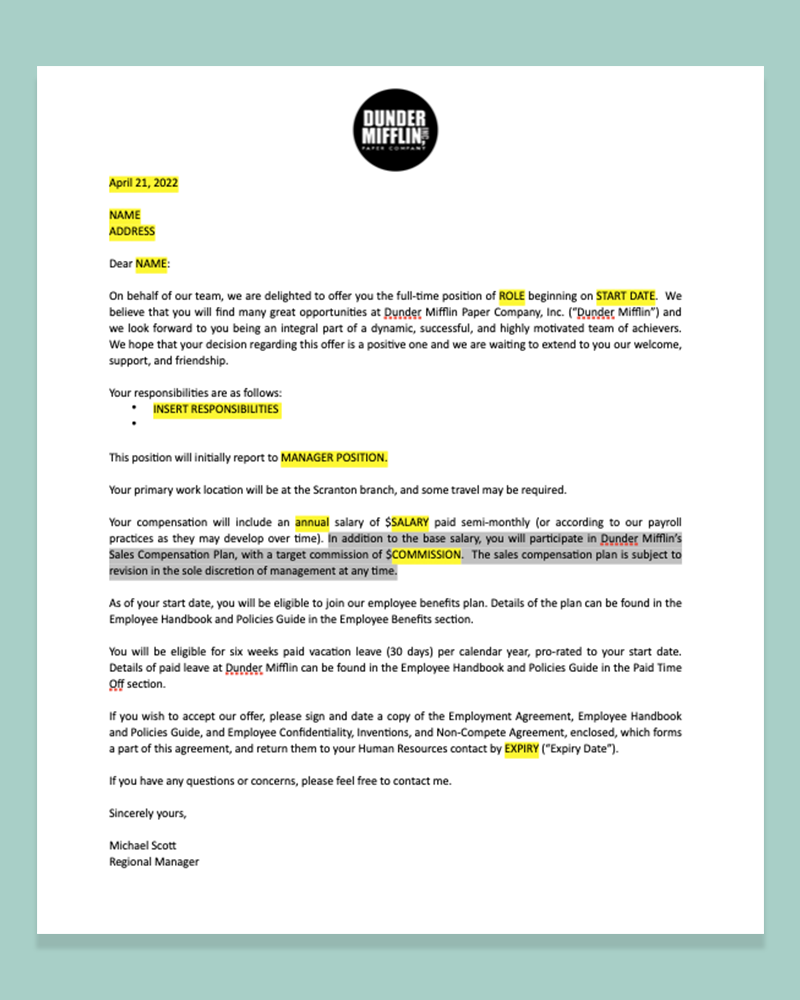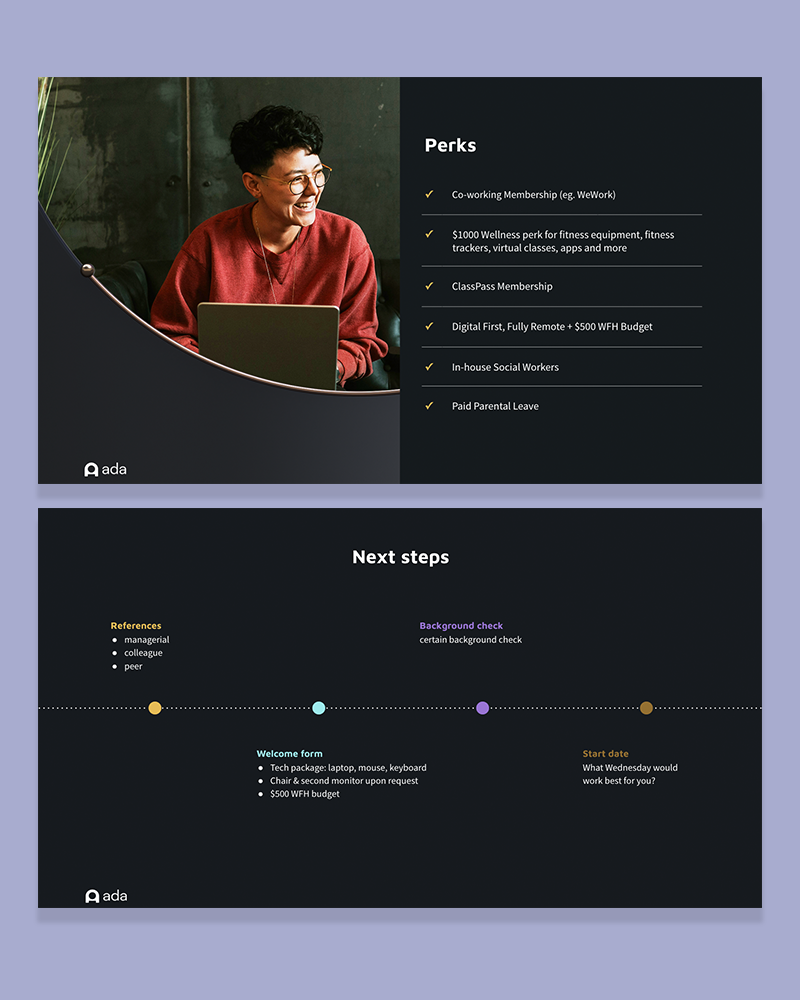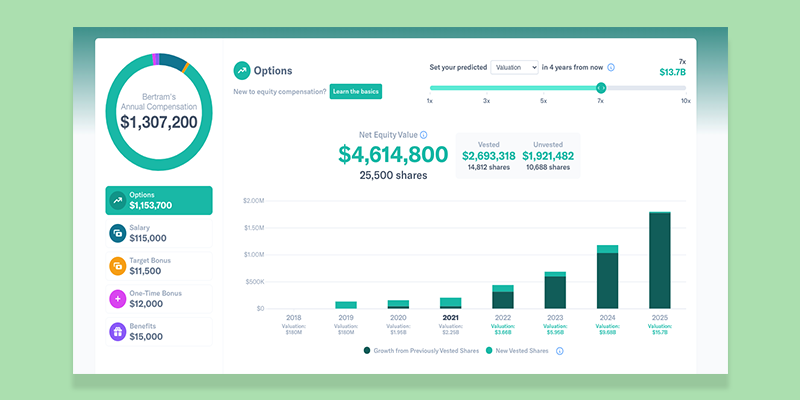Writing an offer letter involves more than you may think. And it’s essential to get right if you want the candidate to accept it. Because even if you’ve already discussed the ins and outs of the role before reaching the decision phase, an offer letter is your last chance to make the case for why someone should work for you.
What Is an Offer Letter?
An offer letter is a written document given to job candidates that acts as a formal job offer and outline for the terms of employment.
“Throughout the entire process, every single touch point, we are selling the role to our candidates,” Hailey Hastings, head of talent acquisition at automated brand interaction company Ada, told Built In. “You want to make your offer exciting for the candidate, so that they know what their impact will be.”
Sending and signing an offer letter is the final step in recruiting a new teammate. Here’s how to write one they simply can’t turn down.
See how your employer brand is performing in AI tools like ChatGPT and Google.
How to Write an Offer Letter
Seek Professional Legal Advice
Offer letters aren’t necessarily legal documents, but if an employee agrees to the terms set out by an employer in an offer letter, a candidate may argue the employer is legally bound to deliver on the conditions listed in that letter. Failing to meet those obligations may come back to bite you.
“Something that was legal a month ago, might not be anymore, and might be ruled against you in the future if you don’t change it,” Joanna Woo, head of people at industrial process automation company CruxOCM, told Built In.
Since both you and your future employee will be putting signatures on the offer, Woo said it’s crucial that HR leaders run their offer letters by a legal professional before sending them out to candidates.
Prioritize Transparency Throughout the Interview Process
Candidates expect offer letters to confirm the terms and conditions of the role that you’ve already discussed, so nothing listed in it should come as a surprise.
Throughout the interviewing and candidate screening process, make an effort to be as transparent as possible about what they’ll be getting if they join your team and what the role’s expectations will be. If you wait until writing your offer letter to share info about equity or benefits, you run the risk of not getting a candidate’s signature.
“If we can’t give the candidate what they want, we need to tell them up front,” Hastings said. “It’s not fair to sell them something they won’t actually get.”
Design Creative Offer Letters to Get Candidates Excited
Employers need to look at their offer letters as a tool to lock down top talent. Think beyond the traditional PDF or document, and use your offer letter to get an enthusiastic ‘yes’ from candidates. Scott Ginsberg, senior content marketing manager at compensation software company Pave, said that compelling visuals are one thing employers can include in their offer letters to get candidates excited about their potential role.
“You can win more candidates by helping them visualize the upside of their offer, most notably with a visual offer letter,” Ginsberg told Built In. “This can help you eliminate confusion around equity by visually communicating total rewards to employees, and deliver a transparent and compelling narrative around your organization.”
What to Include in an Offer Letter
To make sure you cover all your bases when writing an offer letter, include the following details.
Role Expectations
After you’ve congratulated the candidate on being chosen for the role, outline exactly what that role entails. State their position, manager and team. Beyond that, highlighting some details about their daily tasks and how they’ll contribute to company initiatives overall will help them better see how they’ll fit into your team.
Start Date
Give the candidate information about their start date, which can be determined by the amount of notice they’ll need to give their current employer as well as any recruiting timeline goals on your end.
Compensation
In the offer letter, include their starting salary or hourly rate. Some cities and states also have pay transparency laws that require employers to share salary ranges or pay scales with job applicants. Double-check any local and state regulations, and be sure any pay ranges or scales in your offer letter align with information shared in interviews and job postings.
Equity
If your company offers equity as a part of its compensation package, include some details about what can be expected in your offer letter. Equity is a powerful way to tie employees’ personal goals to the overall goals of your company.
“That way,” Hastings said, “they’re invested in us as much as we are in them.”
Benefits
More than just a salary, job candidates want to know that their future employer will be able to take care of their needs. Sharing information about the benefits you offer is another important way to draw candidates in, so be specific.
Location Info
A 2024 Robert Half survey reveals that over a third of workers who plan to look for another role list a desire for more flexibility as their main reason. If employers aren’t already including office location and workplace flexibility in their offer letters, they should start doing so right away, Woo said.
Termination Clause
Employment laws vary from state to state, but most offers will involve at-will employment, which means that management can terminate an employee at any time. This is as long as they’re not under a valid contract or the termination isn’t discriminatory or illegal. Including a termination clause that outlines these expectations in detail is important so that there’s no confusion.
If you’re hiring an employee on a contractual basis, include the timeline of that contract, as well as what will happen to their employment status once the contract period has ended. In such cases, Woo said it’s smart to play it safe.
“Your best bet is actually to have shorter contracts, and then extend them before the contract ends,” Woo explained.
Acceptance Deadline
Once you’ve nailed down a start date, make sure that your potential employee agrees to the offer and provides their signature before their employment begins.
“Offer letters need to be signed before the start date for them to be legally binding,” Woo said. “Sometimes companies have a verbal agreement and have somebody start and then show them the offer letter. I try to avoid that because then it’s hard to prove the start date.”
Offer Letter Examples

Basic Offer Letter
For companies on a tighter budget, a no-frills traditional letter works just fine. Above is an example of a basic offer letter template Woo drafted up, complete with The Office references.

Informal Offer Deck
An offer letter doesn’t have to look like a legal document. At Ada, Hastings’ team sends out a more informal slideshow deck that candidates can scroll through to learn about the role.
“We put the person’s name, their photo and a big congratulatory message welcoming them to the team and saying we’re excited to have them,” Hastings said. “Then we go through their job title, their salary, stock options and start dates.”

Interactive Offer Letter
Rather than typing up a document with salary and equity data, Ginsberg’s team uses Pave’s own internal offer letter platform to let candidates explore their potential stock options and see how they may change over time in an interactive way.
Offer letters may seem like dry documents, but if done the right way, they can set an exciting tone for a future employee’s experience. After getting the nitty-gritty details out of the way, remember to celebrate the offer.
Frequently Asked Questions
Is an offer letter legally binding?
No — by default, an offer letter is not considered a legally binding document, but the legal consequences of one can still vary depending on the specific terms it outlines.
This means an employer may rescind a job offer until a job candidate signs and accepts an offer letter. It also means that if an employee agrees to the terms outlined in the offer letter, they may be legally bound to deliver on those terms.
What is included in a job offer letter?
An offer letter for a job will often include the following information:
- Job title and role expectations
- Start date of the job
- Compensation, benefits and equity
- Office or working location
- Termination clause
- Acceptance and signature deadline
What not to say in an offer letter?
For companies that follow at-will employment, avoid using language that could be interpreted as a statement about the length of employment. In addition, make sure any details regarding pay, benefits and other job aspects match what was discussed earlier in the interview process. Candidates shouldn’t be surprised by any role details in a job offer letter.
Who signs off on an offer letter?
Recruiters and hiring managers are typically the company personnel who sign off on an offer letter for final approval.
Should an offer letter include PTO?
It’s best practice for an offer letter to cover compensation, benefits and other key job details — including PTO. Be sure that any salary data and other aspects of the role match information shared in previous conversations, so candidates don’t feel blindsided or misled.





